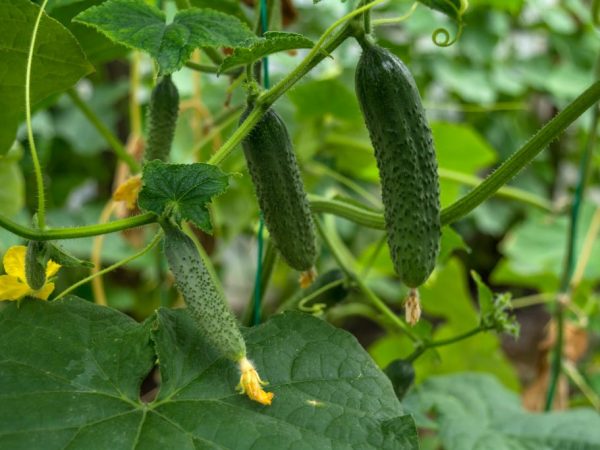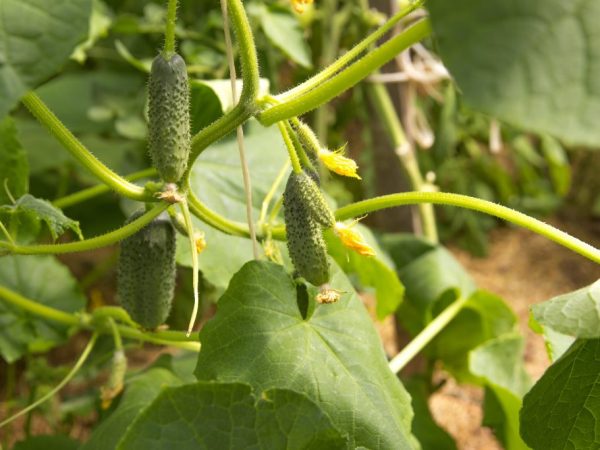Characteristics of the Lilliput cucumber
Cucumber variety Lilliput F1, due to its hybrid origin, has many positive qualities. This type of vegetable crop was bred for cultivation in the middle lane.

Characteristics of the Lilliput cucumber
The variety is distinguished by its unpretentious care and resistance to many diseases. The fruits have good taste and long shelf life.
Variety characteristic
Lilliputian cucumbers have a number of characteristics:
- Active growing season, lasting from 37 to 42 days, due to which the variety is considered early maturing.
- The average yield from 1 bush is 10.7 kg.
The culture is grown using a closed method. When planting seedlings in open ground, cucumbers need a film cover. Trellises are also suitable for growing the variety: the shoots of the Lilliput variety weave well, and the presence of a frame will facilitate plant care and increase yields.
Cucumbers grow well even in unfavorable conditions. They also endure lack of proper care and are suitable for summer cottage planting.
Description of the bush
The weaving of cucumbers is fast, there is a tendency to form determinant lateral shoots. The bushes are medium-sized, the type of flowering is female. The ovaries have a bundle shape. For each leaf node, there are 3 to 10 female-type flowers. The leaves are medium in size, ranging in color from green to dark green.
Description of fruits
The fruits are universal: they can be used both for salads and for preservation.
There are certain standards for this type of crop. The description of Zelentsov includes the following characteristics:
- fruit length - from 7 to 9 cm;
- diameter - up to 3 cm;
- average weight - 90 g.
The surface of the cucumbers is covered with medium-sized tubercles, the thorns are predominantly white. The variety is characterized by the presence of light stripes along the fruit. The shape of the zelents is cylindrical. The taste is pronounced, the fruits themselves are distinguished by good strength.
For pickles, cucumbers must be harvested every day during ripening. If the purpose of growing is gherkins, the collection should be done every 2 days.
With an irregular harvest, the fruits increase in volume. However, at the same time, the greens do not lose their taste, do not barrel and do not turn yellow.
Culture care

Good plant care will ensure the harvest
The hybrid origin makes Lilliput F1 cucumbers unpretentious, however, for a good harvest, they need to provide the appropriate conditions.
Watering
Watering the bushes depends on the stage of the growing season. Before flowering, 6 liters of water should be applied per 1 m² in dry weather and 4 liters after rain. During the period of fruit formation, cucumbers require more moisture, so the irrigation rate increases to 9 liters in dry weather and 6 after precipitation.
Watering is recommended in the morning with warm water. It is not recommended to water the bushes in the evening: during the night the plants can freeze due to the cooling of the moisture.
Hilling
Lilliputian cucumbers experience discomfort with the formation of an earthen crust after watering, so the bushes should be spud.It should also be borne in mind that the root system of the crop is near the surface, and careless actions can cause mechanical injury to the plant.
Top dressing
Phosphate fertilizers or ash can be used as top dressing. These types of nutrients make the taste of the fruit richer, thanks to the mineral components. The Lilliput variety does not tolerate an excess of organic matter and sulfate fertilizers. Top dressing should be done twice a season.
You can also apply fertilizer along with watering. Urea diluted in water in proportions of 10 g per 10 l is used as a solution.
Trimming and shaping
Bushes of this type need to be pruned, since the lateral lashes grow extremely quickly. Their surplus can lead to a decrease in yield due to a lack of light for fruits under dense weaving.
Bush pruning is carried out during the period of active growth. At the same time, it is desirable to leave the central stem and the first lateral shoots intact.
Diseases and pests
F1 hybrids have an innate resistance to many diseases that affect this crop. However, prevention will reduce the risk of the disease to a minimum.
The early maturity does not allow this species to be treated with harsh chemistry, as this can lead to toxicity in the cucumbers. In the fight against diseases, homemade mixtures are most often used:
- Powdery mildew does not tolerate a mixture of iodine, milk and laundry soap. The leaves of the bush should be treated with a similar solution.
- As a prevention of gray and white rot, you can use water with the addition of baking soda.
- Bacteriosis is vulnerable to trichopolum. For 1 liter of water, 2 tablets of the drug are diluted and the crown is treated.
Insects can do more damage to crops than disease. Of particular danger to the species are slugs and spider mites. So that the pests do not destroy the crop, it is necessary to dig up the site in the fall and leave the ground to freeze.
Dill or garlic can also be planted between the beds. Such plants scare away insects with a specific smell.
Before planting, seeds must be calcined and soaked in nutrient solutions. This will have a beneficial effect on the immunity and productivity of plants.
Conclusion
Cucumber Lilliput belongs to self-pollinating hybrids. This species has many positive characteristics and is suitable for growing pickles and gherkins.
The fruits of this variety are most often used for conservation because of their size and strength. They are also grown for sale, since the greens can withstand long transportation and retain their taste for a long time.

